5e Races That Give Intelligence
Creating a graphic symbol in Dungeons & Dragons 5e is a chance to footstep into a dizzying fantastical globe total of adventure, dungeons, and strange monsters to fight.
In addition to owlbears, heed flayers, and the undead, the many worlds of D&D are home to dozens of sentient races with wildly dissimilar physical characteristics, cultures, and abilities.
These races range from the humble homo and other "classic" fantasy humanoids like elves, dwarves, and halflings to snake people, birdfolk, deep gnomes, and half-giants.
The one affair that unites the people from all these different races is that, sooner or subsequently, some of them decide to become adventurers.
Welcome to our guide to playable races in D&D 5e, an introduction to every commonplace and exotic lineage you lot can employ to build your next graphic symbol, forth with some communication on which playable races work all-time as function of unlike character builds.
We've grouped our entries into two sections for this guide.
Commencement up are the nine "classic" fantasy races constitute in the Actor's Handbook.
So, we've included the other 34 "fantastical" races that were previously scattered throughout Mordenkainen's Tome of Foes, Volo'due south Guide to Monsters and other supplements like The Wild Across the Witchlight merely were recently gathered together in a revised format every bit part of Mordenkainen's Monsters of the Multiverse as well every bit other "exotic" options for playable races from other sourcebooks.
Monsters of the Multiverse and v.5e
Traditionally in D&D 5e, different playable races were afforded dissimilar innate bonuses (or, in some cases, penalties) to their ability scores.
Increasingly, as the chat in the D&D community shifts toward ways to avoid problematic ideas like bioessential racial traits, especially negative ones, Wizards of the Coast has started reworking the side by side generation of the D&D 5e rules to make races more flexible.
This helps get effectually some tricky ideas, like inherent alignment or the fact that all orcs previously started out in life with an intelligence penalty, but information technology as well opens upwards a whole load of new opportunities to play unlike course/race pairings that previously would have been mechanically suboptimal.
Ability Score modifiers accept been decoupled from character race. Now, all characters using this method of generation become to either increment one ability score by +2 and another by +one or increment three different scores past +one.
You still tin't increase a starting ability score to a higher place 20.
Custom Lineage
If the twoscore+ options for playable races don't offer enough variety — or perhaps y'all're a dungeon chief looking to create playable races for your homebrew setting — and then the Custom Lineage rules from Tasha'southward Cauldron of Everything are a new way to create counterbalanced "legal" characters who aren't based on an existing race.
When you create a custom lineage character, you give them the following traits.
- Creature type: You are a humanoid. You decide your appearance and whether you resemble any of your kin.
- Size: You are Small or Medium (your choice).
- Speed: Your base of operations walking speed is thirty feet.
- Ability Score Increase: One power score of your choice increases by 2.
- Feat: You gain one feat of your choice for which y'all qualify.
- Variable Trait: You gain i of the following options of your choice:
- Darkvision with a range of threescore anxiety.
- Proficiency in one skill of your choice.
- Languages: Yous can speak, read, and write Common and ane other language that y'all and your DM agree is appropriate for your character.
"Archetype" Playable Races
This section deals with the nine grapheme races plant in the Role player's Handbook, which include humans and iconic nonhuman races that have been a role of D&D since the primeval edition of the game, like elves, dwarves, and halflings (although Gary Gygax repeatedly swore that Tolkein wasn't an influence on the game) too as some other, more exotic options.
1. Dragonborn

- Powerful jiff weapon attack
- Damage resistance is super powerful
- New subclasses add versatility
Resembling humanoid dragons, the first dragonborn were created long ago, either built-in from sorcerous experimentation or forged by the draconic gods.
Dragonborn scales — in one case every bit lustrous equally those belonging to the true dragons — accept faded over the generations, only the jiff in their lungs remains simply as powerful.
Dragonborn are all distantly related to a particular type of dragon and proceeds a breath-weapon set on tied to their particular colour as well as resistance to a particular damage type associated with their draconic ancestry.
If yous're playing a standard dragonborn from the Thespian's Handbook, then the +2 Charisma bonus along with some added Strength makes dragonborn especially skillful candidates for the Paladin class.
If you're playing ane of the 3 new dragonborn subraces released every bit part of Fizban'south Treasury of Dragons, so you proceeds admission to some additional elemental damage immunity, an incapacitating breath weapon, or psionic abilities depending on whether your draconic ancestry is chromatic, metallic, or precious stone.
You also get to distribute your Ability Score increases the new way, which ways that simply nigh any class is a corking fit for these types of dragonborn.
2. Dwarf
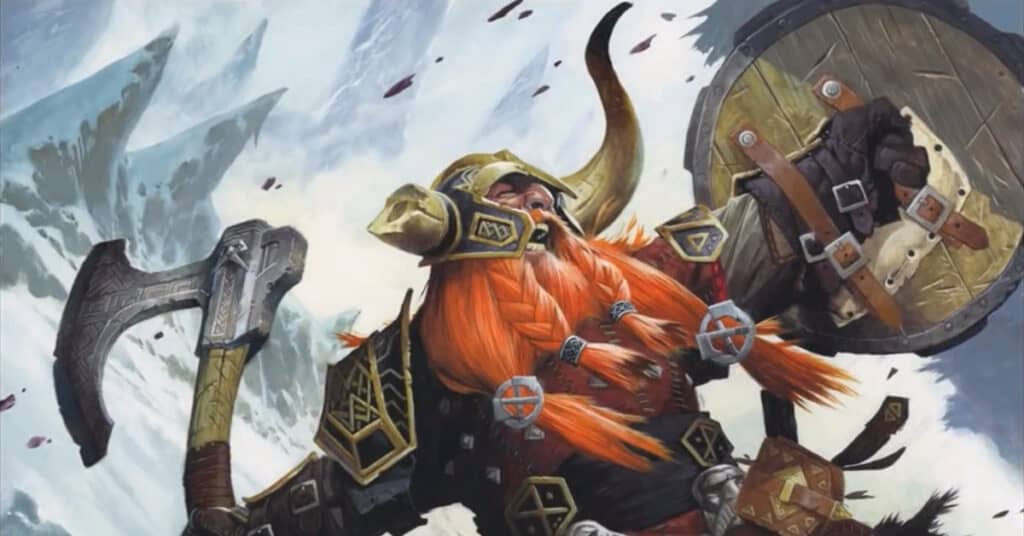
- Tough and tanky
- Weapon and armor proficiencies great for adding survivability to casters
- Could be tough to break out of the "Classic Fantasy Dwarf" mold when roleplaying
Built-in below rock and the weight of history, dwarves are a proud people bound by tradition and duty to the clan, master stoneworkers, and artisans too equally fierce warriors.
They have a natural resistance toward poisonous substance and are trained from a young historic period to exist equally comfy wielding their hammer over a burning forge as in boxing with a horde of goblins.
Dwarves make excellent Forcefulness-based martial characters, although in that location's no reason that you can't make full the iconic dwarven cleric role or even play a Ranger or a Druid with the Hill Dwarf's extra Wisdom point.
three. Elf

- Tall, haughty, hot and know it
- Rangers and rogues par excellence
- Drow in particular go great innate spellcasting
Elves are probably synonymous with the fantasy genre, and D&D 5e is no exception.
If yous want to play an elf, y'all're going to be spoiled for choice as the feywild-native Eladrin, the mournful Shadar-Kai, and the aquatic Ocean Elves all fall under this umbrella.
Given their rarity and the different mechanical assumptions fabricated virtually them all the same, they've been moved over into the 2nd half of this commodity.
This entry is concerned with the iii types of elf found in the Player's Handbook: High Elves, Wood Elves, and Dark Elves (also known every bit Drow).
Graceful, dextrous, ageless — elves are an otherworldly race who choose to dwell in places of ethereal tranquility in balance with the natural world, except the drow, of course, but their long sojourn in the Underdark and what it has done to their culture serves equally a sit-in of what happens when elves fall out of step with the natural earth (I judge worshiping an evil spider goddess doesn't help).
All elves are distantly descended from beings of the feywild and are naturally resistant to magic that would charm them and can't be magically put to slumber.
They also don't need to slumber normally, falling into a meditative trance instead.
Different elven subraces grant a range of benefits from innate spellcasting and weapon training to an almost supernatural ability to hide amongst the trees, significant elves can be well suited to a broad variety of grapheme classes.
iv. Gnome
- The archetypal artificer
- Advantage on all saving throws vs. magic is insanely powerful
- Still won't ever be cool
Curious, analytical, and joyous, gnomes tend to please in life and the exploration of its mysteries.
Their communities bustle with the sound of abiding tinkering and invention, and few cultures marry magic and what passes for applied science in the various worlds of D&D.
In addition to having advantage on all saving throws against magic thanks to their gnome cunning, both gnomish subraces get evocative and interesting abilities, similar the Forest Gnome's ability to communicate with animals and the Stone Gnome's proficiency at creating pocket-sized mechanical marvels.
5. Half-Elf
- Adapts to near anything
- The objectively best selection for bards and other charisma-based classes
- Interesting roleplaying opportunities
Being caught between two worlds has made half-elves adaptable, and truly belonging to neither has fabricated them independent, even though they like to say they take on the best qualities of their human and elven parents.
Half-elves age at much the same rate as humans, just although they will never live as long as an elf, they tin even so virtually double the expected lifespan of a human.
Mechanically, whatever class that values Charisma tin exist a good fit for a Half-Elf, only it's the synergy betwixt this class'due south extra skill proficiencies and the Bard's Expertise that makes for a truly classic pairing.
six. Half-Orc

- Top-tier barbarians
- Relentless Endurance is hugely impactful at lower levels
- Way more interesting to roleplay than half-elves
Born of the union between 2 worlds, Half-Orcs walk the line between the primal fury of their Orcish ancestors and the more cognitive influence of their human parentage.
Larger and bulkier than humans, a Half-Orc is yet dwarfed by a full-blooded Orc.
This doesn't forestall them from being but as fearsome in boxing, capable of dishing out extra damage on a critical hit, staying conscious when knocked to 0 hit points, and gaining proficiency in the intimidation skill.
One-half-Orcs make classic fighters and barbarians (especially if you desire to embrace the orcs' more tribal civilization as a foundation for the barbarian's ain abilities), although they could hands make excellent Rangers, Paladins, and Clerics.
7. Halfling

- Lucky, Brave, and Nimble are all superb
- The perfect rogue
- Selection the Ghostwise if you resent the idea of beingness a jolly little hobbit
Naturally gregarious, potbellied, and fond of life's simple comforts, not many Halflings forgo the luxuries of abode for a life as an charlatan. The ones that exercise, even so, observe themselves well suited to the profession.
Halflings are nimble, courageous, and possess reserves of luck far larger than their minor physiques (which allow them to reroll natural 1s on any ability check, assault roll, or saving throw).
8. Human
- Infinite variety, highly versatile
- A Feat at 1st level is absolutely top tier
- Or at least, it was until Custom Lineage came out
The about widespread, simple, and versatile race in D&D, humans are everywhere and can practice just nigh annihilation meliorate than virtually — even if it'south not equally good as some.
The Standard human tin can increase every single ane of their ability scores past i, whereas the Variant human gets to choice a feat and increase two stats of their selection.
9. Tiefling
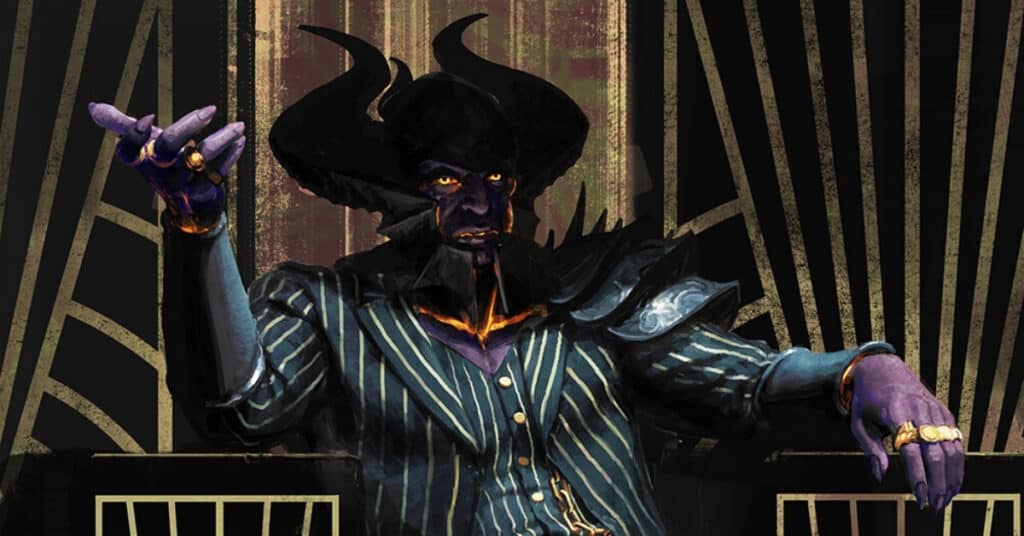
- Super-powerful innate spellcasting
- Fun, demonically driven roleplaying opportunities
- Shame near all the infernal lineages getting axed by MotM
Cursed by an ancient sin — a deal struck between their forefathers and a prince of the Nine Hells — tieflings are doomed to forever exist outsiders in the worlds of mortals, feared and mistrusted; for whether information technology'due south horns, a forked tongue, or dark-scarlet peel, they wear their lineage where others can see it.
Tieflings exercise get some powerful advantages equally a result of their fiendish heritage, however.
They are resistant to fire damage and get access to some useful innate spellcasting, including the Thaumaturgy cantrip, Hellish Rebuke, and Darkness.
In that location are several more tiefling bloodlines tied to the other archdevils of the nine hells, but they were published in Mordenkainen'south Tome of Foes and are therefore now considered legacy content.
This is a shame, considering Mordenkainen'due south Monsters of the Multiverse appears to have washed null to redress the famine of tiefling variety — although y'all can even so notice rules for the Sword Coast Charlatan's Guide's variant tieflings here.
Fantastical Races
Beyond the 9 "archetype" fantasy races that grade the cadre of D&D 5e's playable races, there's a whole multiverse of variety and strangeness.
At that place'south everything from playable races inspired past Greek mythology, similar the satyr and minotaur, to traditionally "monstrous" races given new life as playable options, like the goblin, bugbear, and orc, not to mention species from the farthest flung corners of the planes like Fairies, elemental Genasi, and the Gith.
Unless otherwise specified, all the races listed in this section use the new grapheme generation rules from Monsters of the Multiverse .
- Ability Score Increases: Either +two in ane score and +1 in another, +1 in three different scores. No score may be increased above 20.
- Languages: All characters can speak, read, and write Common and one other linguistic communication advisable to the character.
1. Aarakocra

- Creature Type: Humanoid
- Size: Medium
- Speed: 30 anxiety
- Flight: Aarakocra not wearing medium or heavy armor have a flying speed equal to their walking speed.
- Talons: Unarmed strikes deal 1d6 + Strength slashing damage.
- Current of air Caller: Innate spellcasting lets you bandage Gust of Current of air one time per long rest (or using a 2nd level spell slot) once you achieve 3rd level.
Winged, feathered humanoids from the elemental airplane of air, Aarakocra are a nomadic people who gained the power of flight in service to the Wind Dukes of Aaqa.
On the material plane, the Aarakocra made their homes in treetops loftier in the mountains. Here, they are explorers, immigrants, and refugees.
With a mixture of flight and innate spellcasting, Aarakocra are a highly mobile and versatile player race that can find themselves well suited to any class that doesn't require them to vesture medium-heavy armor.
Rogues, Barbarians, and Druids are all great choices here — as are Monks, given the boost to unarmed strike damage that Aarakocra receive due to their talons.
ii. Aasimar

- Creature Blazon: Humanoid
- Size: Medium
- Speed: 30 feet
- Angelic Resistance: Resistance to necrotic and radiant damage
- Darkvision: 60 feet
- Healing Hands: Once per long rest, touch a creature and roll a number of d4s equal to your proficiency bonus, restoring that much hp to the creature.
- Lightbearer: Innately cast the light cantrip (CHA spellcasting modifier).
- Celestial Revelation: At 3rd level, cull between Necrotic Shroud, Radiant Consumption, and Radiant Soul, each of which grants a different celestial do good, from flying speed to extra damage.
Touched by a spark of the upper planes, Aasimar are to celestials as Tieflings are to fiends.
They aren't necessarily the offspring of a angelic and a humanoid, although that can be the case; some aasimar are created when a mortal is infused with divine power.
Aasimar take a mixture of useful racial traits, of which their Healing Hands are especially powerful — seeing as this is effectively a version of the Paladin's Lay on Hands ability.
Also, the Angelic Revelation that all Aasimar receive at 3rd level can be a lynchpin of a character build, not to mention increase your damage output noticeably.
3. Bugbear
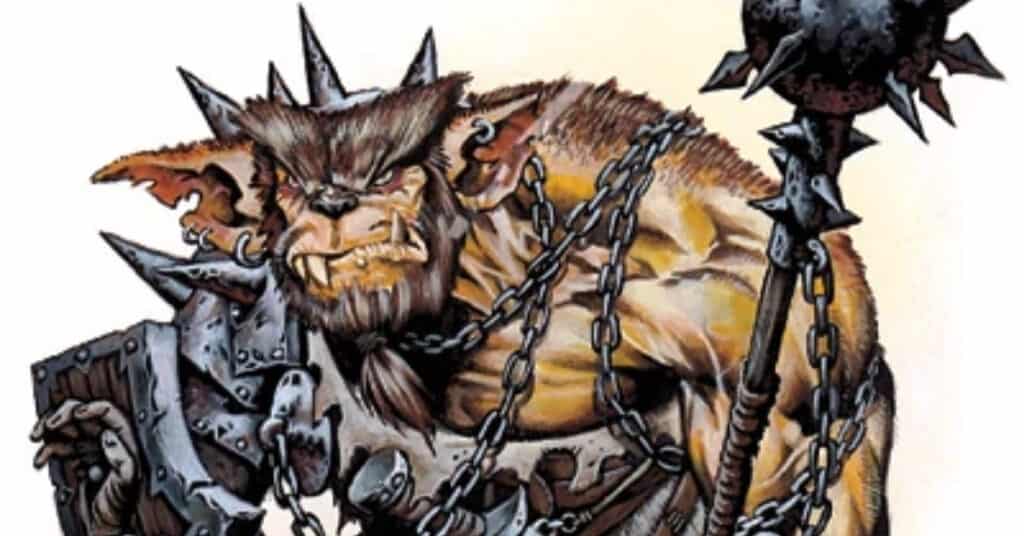
- Creature Blazon: Humanoid (also a goblinoid)
- Size: Medium
- Speed: 30 feet
- Darkvision: 60 feet
- Fey Beginnings: Reward on saving throws to avoid or end existence charmed
- Long-Limbed: Melee assail reach increased by 5 feet.
- Powerful Build: Count as one size larger when determining carrying capacity also as weight you can comport, elevate or elevator.
- Sneaky: Proficient in Stealth and can motility through a infinite large plenty for a small creature.
- Surprise Assault: If you hit a brute before it has taken a plough in the current combat, it takes an extra 2d6 damage.
Big, hairy, hulking — bugbears are the biological cousins of goblins and hobgoblins, although they are significantly larger than both of them.
Despite their size, bugbears are remarkably stealthy, and their fey ancestry expresses itself in an ability to hide and move through spaces that seem far too pocket-size to adapt their massive frames.
Mechanically, bugbears take an atrocious lot going for them. Their additional 5 feet of attain means that, if yous equip i with a attain weapon of some kind and the Scout feat, they become virtually unmatched at controlling the battleground.
Their Sneaky and Surprise assail features too make them amazing candidates for the Rogue course, particularly the assassinator. Too, they can get more out of the Alert feat than only about any other playable race.
4. Centaur
- Creature Type: Fey
- Size: Medium
- Speed: 40 anxiety
- Charge: If you move 30 anxiety toward a target and hit with a melee weapon set on, you can make a bonus action attack with your hooves.
- Equine Build: You're half horse, so you count every bit one size larger when determining conveying chapters, and any climbing that requires hands and feet costs 4 anxiety of movement for every ane foot.
- Hooves: Unarmed strikes deal 1d6 + Strength bludgeoning.
- Natural Affinity: Proficiency in Animate being Treatment, Medicine, Nature, or Survival.
Centaurs from the Feywild have a mystical connection to the natural world. Their powerful back legs make for useful unarmed weapons which, combined with their twoscore foot movement speed, means they brand excellent monks.
5. Changeling
- Creature Type: Fey
- Size: Medium or Minor
- Speed: 30 anxiety
- Changeling Instincts: Proficiency in two of the following skills: Deception, Insight, Performance, Persuasion.
- Shapechanger: As an action, alter your appearance and voice, including duplicating the appearance of another individual you've seen before.
Changelings alive in cloak-and-dagger equally role of many different societies throughout the multiverse, able to perfectly blend in amid other unsuspecting races.
The kickoff changelings originated in the feywild, although they can at present be plant only well-nigh anywhere — bold you know how to look.
Mechanically, a changeling can be a skillful fit for just about whatever role, although it'due south as a Rogue or Bard where they truly shine.
6. Deep Gnome (Svirfneblin)
- Creature Type: Humanoid
- Size: Pocket-size
- Speed: thirty feet
- Darkvision: 120 feet
- Souvenir of the Svirfneblin: From third level, y'all tin can bandage Disguise Self. From fifth, you can cast Nondetection. Once yous cast either spell, yous must accept a long rest earlier yous can cast one again. Cull Intelligence, Wisdom, or Charisma as your spellcasting-ability modifier at character creation.
- Gnomish Magic Resistance: Advantage on saving throws against spells.
- Svirfneblin Camouflage: Advantage on stealth checks a number of times per long rest equal to your proficiency bonus.
Small-scale, secretive natives to the Underdark, the deep gnomes are a supernaturally stealthy race of stonecutters and foragers.
Their innate spellcasting and natural camouflage make them outstanding Rogues or Rangers, and their advantage on saving throws against magic is amid the most powerful racial bonuses in the game.
7. Duergar
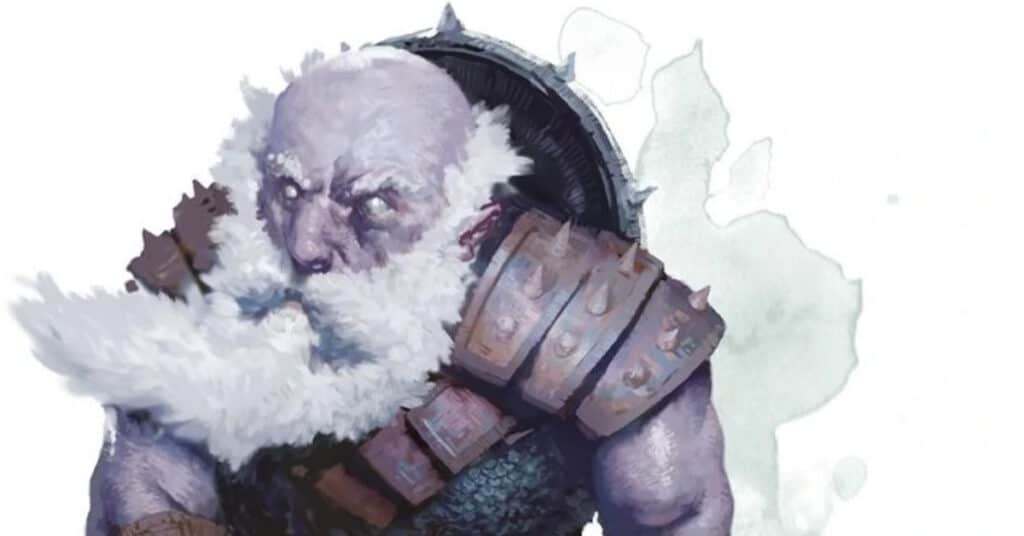
- Creature Type: Humanoid
- Size: Medium
- Speed: 30 feet
- Darkvision: 120 feet
- Duergar Magic: 3rd level overstate/reduce and 5th level invisibility once per long rest. Choose Intelligence, Wisdom, or Charisma as your spellcasting ability modifier at character cosmos.
- Dwarven Resilience: Reward on saving throws against toxicant and resistance to poison damage.
- Psionic Fortitude: Advantage on saving throws confronting the overjoyed and stunned conditions.
All dwarves are at home underground, merely the ancestors of the Duergar delved deeper than whatsoever other, all the way down into the underdark.
Far below the surface world, these deep dwarves were warped by the foreign magical energy — a transformation that was but accelerated past the barbarous experiments of mind flayers and other aberrations.
As a result, Duergar have minds that are open to psionic abilities and resistant to outside interference.
The Duergar's innate spellcasting and psionic fortitude offer an interesting mixture of survivability and durability, which make this race excellently suited to playing just virtually whatsoever form.
8. Eladrin
- Beast Blazon: Humanoid (elf)
- Size: Medium
- Speed: 30 anxiety
- Darkvision: lx feet
- Fey Ancestry: Advantage on saving throws to avoid or end being charmed.
- Fey Stride: Teleport upwards to 30 feet equally a bonus action with a special effect depending on your called flavour.
- Keen Senses: Proficiency in Perception
- Trance: Meditate instead of sleeping. Lets you change season. Whenever you lot end a trance, proceeds 2 new weapon or tool proficiencies you lot don't take.
Eladrin are a subrace of elves native to the Feywild.
Untamable, child-bearing, and fiercely free, the Eladrin are ruled past their emotions and innate connectedness, both to the irresolute seasons of the natural world and to the roiling fey magic that lives within each of them.
Fey Footstep offers a drastic increase in the Eladrin's mobility (assuasive them to get in and out of gainsay as and when they need), and the extra seasonal effects bring a big amount of boosted versatility to this player race, allowing you to charm, frighten, or damage your enemies and even let your allies teleport instead of you.
ix. Fairy
- Creature Type: Fey
- Size: Small
- Speed: 30 feet
- Fairy Magic: You know the Druidcraft cantrip. From 3rd level, you learn Faerie Fire, and from 5th level you lot tin bandage Enlarge/Reduce. You tin cast a leveled spell in this manner one time per long rest, unless you use a spell slot. Choose Intelligence, Wisdom, or Charisma as your spellcasting-power modifier at character creation.
- Flight: Fairies not wearing medium or heavy armor have a flying speed equal to their walking speed.
Larger than pixies and sprites just smaller than simply about everyone else, Fairies are ane of the archetypal fey races with innate spellcasting and the power of flight.
These chaotic, mirthful folk tend to look similar small elves with insectoid wings, although there are an most countless variety found throughout the feywild and beyond.
10. Firbolg

- Creature Type: Humanoid
- Size: Medium
- Speed: thirty feet
- Firbolg Magic: You tin cast the Detect Magic or Disguise Self spell once per long residuum. Choose Intelligence, Wisdom, or Charisma as your spellcasting-power modifier at character creation.
- Hidden Pace: Magically turn invisible as a bonus action (a number of times per long rest equal to your proficiency bonus) until the starting time of your next turn or until you attack, make a damage ringlet, or force someone to make a saving throw.
- Powerful Build: Firbolgs count as one size larger when computing conveying, lifting, pushing, and dragging chapters.
- Oral communication of Beast and Leaf: You lot can communicate simple ideas with beasts and plants. Y'all have reward on all Charisma checks made to influence them.
11. Genasi

Descended from genies of the elemental planes, Genasi are all tied to one of the iv elements — Air, Earth, Fire, and Water — and embody traits inherited from their ancestral chemical element.
Each genasi gets a nice assortment of resistances and innate spells that makes them experience uniquely tied to their called chemical element too as the genies to whom they are distantly related.
Genasi, Air
- Creature Blazon: Humanoid
- Size: Medium or Small
- Speed: 35 feet
- Darkvision: 60 feet
- Unending Breath: Concur your breath forever if you lot're not incapacitated.
- Lightning Resistance: Resistant to lightning damage.
- Mingle With the Wind: You know the shocking grasp cantrip. From 3rd level, you can cast the feather fall spell, and from fifth level you can bandage the levitate spell (once per long rest or with a spell slot). Choose Intelligence, Wisdom, or Charisma equally your spellcasting-power modifier at character cosmos.
Genasi, Globe
- Animate being Blazon: Humanoid
- Size: Medium or Small
- Speed: 30 feet
- Darkvision: threescore feet
- Earth Walk: Move across hard terrain (walking on the ground) as though it's normal.
- Merge With Stone: You know the bract ward cantrip, which yous can cast equally normal or as a bonus action a number of times equal to your proficiency bonus per long rest. From fifth level you can bandage Pass Without Trace (in one case per long rest or with a spell slot). Choose Intelligence, Wisdom, or Charisma equally your spellcasting-power modifier at graphic symbol cosmos.
Genasi, Fire
- Fauna Blazon: Humanoid
- Size: Medium or Small
- Speed: 30 feet
- Darkvision: 60 feet
- Fire Resistance: Resistance to burn damage.
- Reach Into the Blaze: You know the produce flame cantrip. From tertiary level, you can cast the burning hands spell, and from 5th level you lot can bandage the flame bract (in one case per long residue or with a spell slot). Choose Intelligence, Wisdom, or Charisma equally your spellcasting-ability modifier at graphic symbol cosmos.
Genasi, Water
- Brute Type: Humanoid
- Size: Medium or Small
- Speed: 30 feet (walking and swimming)
- Darkvision: 60 anxiety
- Acid Resistance: Resistant to acrid harm.
- Amphibious: Exhale air and water.
- Phone call to the Wave: You know the acrid splash cantrip. From 3rd level, you can cast create or destroy h2o, and from 5th level y'all can bandage h2o walk (one time per long rest or with a spell slot). Choose Intelligence, Wisdom, or Charisma every bit your spellcasting-ability modifier at grapheme creation.
12. Githyanki

- Creature Type: Humanoid
- Size: Medium
- Speed: 30 feet
- Astral Knowledge: Gain proficiency in a skill, weapon, and a tool of your choice when you finish a long rest.
- Githyanki Psionics: You know the mage manus cantrip (the hand is invisible, like y'all have the Telekinetic feat). From tertiary level, you can cast jump, and from 5th level you tin cast misty step (one time per long rest or with a spell slot). Choose Intelligence, Wisdom, or Charisma as your spellcasting-ability modifier at character creation.
- Psychic Resilience: Resistance to psychic damage.
Psionically gifted interdimensional space pirates, the Githyanki are i half of an ancient race in one case enslaved past the listen flayer empire and at present locked in a bitter ceremonious war.
The Githyanki are the more warlike subspecies of Gith, raiding the material airplane on cerise dragonback or in flying ships fabricated of fe.
As conceptually cool as Githyanki are, their psionics simply don't feel every bit powerful as another races' innate spellcasting, although the invisible mage hand is a prissy touch on.
The power to finer learn a new skill, weapon, and tool every day, withal, is amazing.
13. Githzerai
- Beast Type: Humanoid
- Size: Medium
- Speed: 30 feet
- Githyanki Psionics: Y'all know the mage hand cantrip (the hand is invisible, like you lot have the Telekinetic feat). From 3rd level, you can cast shield, and from fifth level you lot can bandage detect thoughts (once per long rest or with a spell slot). Choose Intelligence, Wisdom, or Charisma as your spellcasting-ability modifier at character creation.
- Mental Subject: Advantage on saving throws to avert or cease the charmed condition.
- Psychic Resilience: Resistance to psychic damage.
Meditative, disciplined, and monastic, the Githzerai are powerful psionicists, specially adept at guarding their own minds against outside interference.
xiv. Goblin
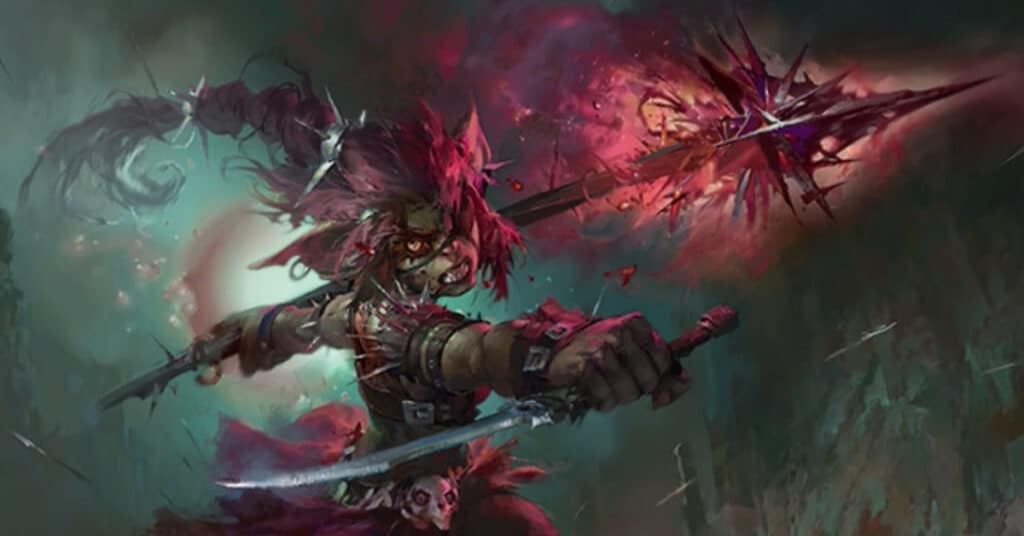
- Creature Type: Humanoid (goblinoid)
- Size: Small
- Speed: 30 feet
- Darkvision: threescore feet
- Fey Ancestry: Advantage on saving throws to avoid or cease being overjoyed.
- Fury of the Small: Bargain extra damage equal to your proficiency bonus when your target is one or more sizes larger than you.
- Nimble Escape: Disengage or Hibernate every bit a bonus action.
Traditionally fiddling more than than fodder for low-level adventurers, goblins are a subterranean folk found just well-nigh anywhere y'all become in the multiverse.
Distantly descended from fey (where they once served the Queen of Air and Darkness) the Goblin people were conquered by the god Maglubiyet and scattered across the textile plane.
Goblins make outstanding martial and spellcasting characters in equal measure, seeing as their Fury of the Minor ability triggers on spell- or weapon-assault damage.
Their Nimble Escape actually makes it kind of a waste to play a Goblin Rogue, withal, every bit you'll be doubling up on Cunning Activeness.
However, if you're thinking nigh injecting a bit of sneakiness into a not-Rogue character, playing a Goblin is a great way to do it.
15. Goliath
- Animate being Blazon: Humanoid
- Size: Medium
- Speed: 30 feet
- Piddling Behemothic: Proficient in Athletics and count as one size larger when determining carrying capacity, etc.
- Mount Born: Resistant to cold damage and can quickly acclimate to high altitudes.
- Stone'southward Endurance: Utilise your reaction to reduce incoming damage by 1d12 + Constitution modifier (number of times equal to your proficiency bonus per long rest).
The closest playable relative of Giants, Goliaths are infused with the supernatural essence of their larger kin (even though at somewhere between 7 and 8 feet tall, they're not puny by whatsoever ways), which makes them suited to life amidst the highest mountains.
The power of Goliaths to reduce incoming damage makes them one of the more durable races to play, meaning they're well-suited to playing a Fighter or Barbarian.
16. Harengon

- Creature Blazon: Humanoid
- Size: Medium or Small
- Speed: thirty anxiety
- Hare-Trigger: Add your proficiency bonus to initiative rolls.
- Leporine Senses: Proficiency in Perception.
- Lucky Footwork: Add together 1d4 to failed Dexterity saving throws as a reaction.
- Rabbit Hop: Leap proficiency bonus x 5 anxiety every bit a bonus activity (a number of times equal to your proficiency bonus).
Exuberant rabbit folk front the feywild, Harengons are bipedal, with long feet and powerful dorsum legs they use for running and jumping with remarkable grace and speed.
With a fairly unique array of mobility and dexterity-based bonuses (including to their initiative scores), Harengons make fantabulous Rogues (particularly assassins), Monks, and even Bards.
17. Hobgoblin
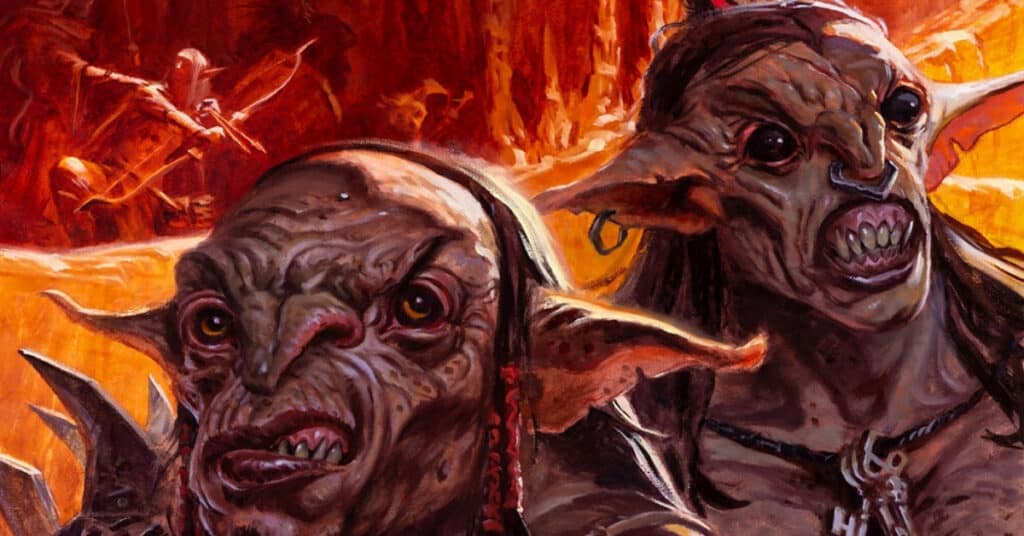
- Animate being Type: Humanoid (goblinoid)
- Size: Medium
- Speed: thirty feet
- Darkvision: threescore feet
- Fey Ancestry: Advantage on saving throws to avoid or end being charmed.
- Fey Souvenir: Help as a bonus action a number of times equal to your proficiency bonus. Also, from 3rd level, you gain additional furnishings, including granting y'all and an marry temporary hp, increased movement speed, or imposing disadvantage on an enemy.
- Fortune of the Many: If you miss with an attack curl or fail an ability bank check or a saving throw, you can gain a bonus to the roll equal to the number of allies yous tin see inside 30 anxiety of you (maximum bonus of +3). Y'all can utilise the trait a number of times equal to your proficiency bonus per long rest.
One time idea of as merely the goblins' smarter, more disciplined and warlike cousins, hobgoblins have undergone some changes recently that put them dorsum in touch with their fey roots.
Mechanically, this has made hobgoblins into one of the best races for a supporting graphic symbol, able to buff and aid their allies better than just about whatever other race.
This makes them an astonishing candidate for the Bard or Cleric class, although players who want their Hobgoblin to be a bit more directly impactful could still play a battle master Fighter.
18. Kenku
- Creature Type: Humanoid
- Size: Medium or Small
- Speed: thirty feet
- Skillful Duplication: Reward on checks to forge or copy writing or craftwork.
- Kenku Recall: Proficiency in ii skills of your option. Give yourself advantage on any skill you're proficient in a number of times per long residue equal to your proficiency bonus.
- Mimicry: Accurately mimic sounds you lot have heard. Detectable only with a DC viii + your CHA modifier + Proficiency bonus Insight bank check.
Feathered humanoids who resemble members of the Corvid family, Kenku reputedly lost their flight and talent for creativity when they stole from their own god many thousands of years ago, dooming them to wander the material plane.
Other Kenku believe their species' excellent memories are a gift and speak to their destiny to witness and record as many of the universe'southward wonders as possible.
With a mixture of insanely useful skill bonus checks and disguise/forgery expertise, Kenku are probably the best candidate for Bards and Rogues (the skill monkey classes) and excel at subterfuge and deception.
19. Kobold
- Creature Type: Humanoid
- Size: Small
- Speed: xxx feet
- Darkvision: 60 feet
- Draconic Weep: Give all your allies (and yourself) advantage on set on rolls against enemies that tin hear you inside ten feet until your next plow. Works a number of times per long residual equal to your proficiency bonus.
- Kobold Legacy: Cull between an extra skill proficiency (Arcana, Investigation, Medicine, Sleight of Hand, or Survival), reward on saving throws confronting being frightened, or a cantrip from the sorcerer spell list.
Kobolds tend to stand about 3 anxiety tall and have long, snout-similar faces somewhere betwixt a canis familiaris and a monitor lizard with scaly skin and red optics that glow in torchlight like an alligator.
They tend to alive underground in vast warrens festooned with traps and are often found worshiping the dragons to which they appear to be distantly related.
Mechanically, the kobold'southward Draconic Cry ability is downright terrifying in a party where more than one character has extra attack (or tin cast spells with attack rolls, preferably multiple rolls like Scorching Ray), or a Rogue, or… basically it's just scary skillful and a spectacular way to start a fight.
20. Lizardfolk
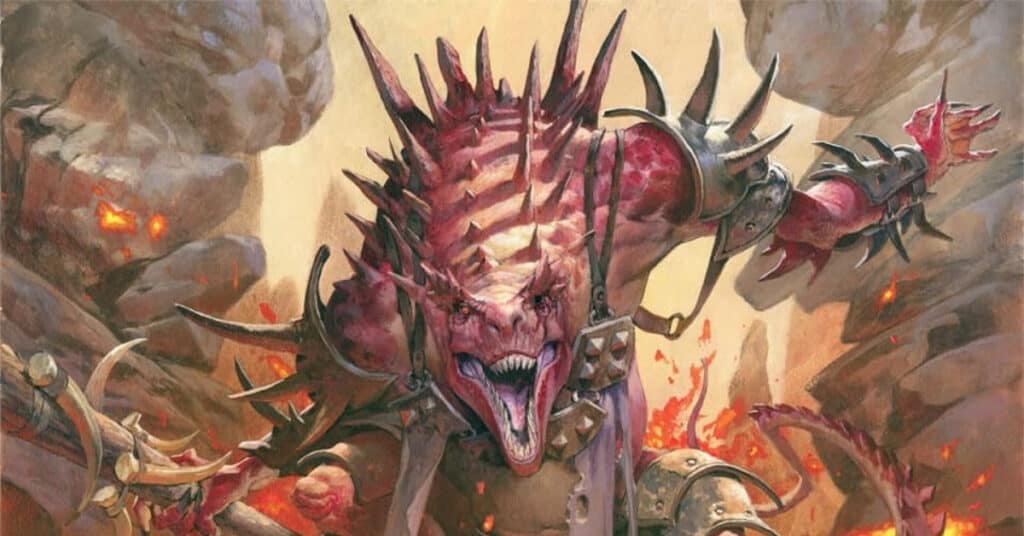
- Animal Type: Humanoid
- Size: Medium
- Speed: 30 feet (walking and swimming)
- Seize with teeth: Unarmed set on (1d6 + Strength slashing damage)
- Agree Breath: fifteen minutes
- Hungry Jaws: As a bonus action, brand a bite attack and proceeds temporary hp equal to the damage. You lot can do this a number of times per long residue equal to your proficiency bonus.
- Natural Armor: Unarmored Air-conditioning equals 13 + Dexterity modifier.
- Nature's Intuition: Proficiency with two skills (choose from Animal Handling, Medicine, Nature, Perception, Stealth, or Survival).
Ancient saurian people who — much like crocodiles — striking an evolutionary sweet spot several one thousand thousand years ago and decided enough was enough.
Many Lizardfolk cultures believe they were placed on the textile plane to guard its natural wonders. Sadly, the emphasis on lizard brain amorality from Volo's appears to be missing in the latest incarnation of this species.
A mixture of natural armor and powerful bite attacks mean Lizardfolk make Dex-based fighters par excellence, not to mention first-class Druids and Rangers.
21. Leonin
- Power Score Increase: Constitution +2, Strength +1
- Creature Blazon: Humanoid
- Size: Medium
- Speed: 35 feet
- Darkvision: 60 feet
- Claws: 1d4 + Force slashing damage
- Hunter's Instincts: Proficiency in one: Athletics, Intimidation, Perception, or Survival.
- Daunting Roar: Once per short or long remainder, you roar, forcing creatures of your choice inside x feet of you that tin can hear you to make a Wisdom saving throw or go frightened (Relieve DC = viii + proficiency bonus + your Constitution modifier).
The Leonin are bipedal cat folk with features resembling lions. Mechanically, they are a Strength-based race that excels in close combat. This isolationist group of proud creatures brand powerful Fighters and Barbarians.
22. Minotaur
- Fauna Type: Humanoid
- Size: Medium
- Speed: 30 anxiety
- Horns: Unarmed attack deals 1d6 + Forcefulness modifier piercing damage.
- Goring Rush: If y'all take the nuance activeness and motility at least xx anxiety, you lot tin can brand an attack with your Horns every bit a bonus activeness.
- Hammering Horns: Push a target 10 feet away with your horns after yous hitting information technology with a melee attack.
- Labyrinthine Recall: Ever know where north is and have advantage on Survival checks to navigate.
Powerfully built, bull-headed humanoids, Minotaurs are blessed with an innately sublime sense of direction.
This is 1 of the reasons people believe the first Minotaurs were created by the Lady of Pain (ruler of Sigil, urban center of doors) to patrol her labyrinths.
In battle, Minotaurs' unarmed strikes are fearsome, making them powerful brawlers and unarmed fighters. Their navigation skills also make them well suited to being Rangers.
23. Orc
- Fauna Blazon: Humanoid
- Size: Medium
- Speed: xxx feet
- Adrenaline Rush: Nuance as a bonus action (number of times equal to your proficiency bonus).
- Darkvision: 60 feet
- Powerful Build: Count as one size larger when determining conveying chapters also as weight you can carry, drag or lift.
- Relentless Endurance: When you are reduced to 0 hp, once per long rest you tin drop to 1 hp instead.
A vehement warrior people created by the one-eyed god Gruumsh, Orcs are tenacious warriors with near-unmatched staying power in a fight.
This makes them ideally suited to the Barbaric or Fighter class, although they are surprisingly adaptable.
24. Satyr
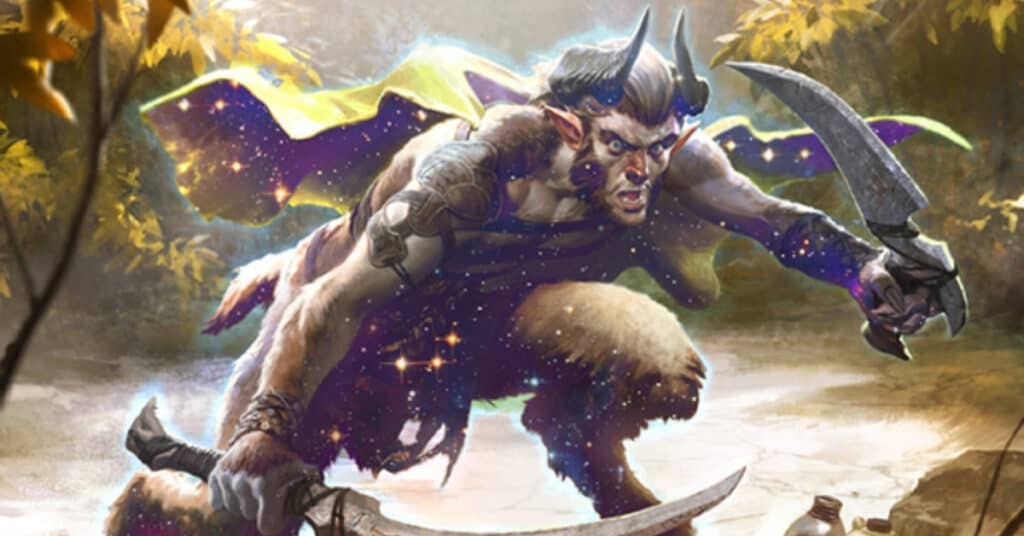
- Creature Type: Fey
- Size: Medium
- Speed: 35 anxiety
- Ram: Unarmed set on deals 1d6 + Strength modifier bludgeoning harm.
- Magic Resistance: Advantage on saving throws against spells.
- Mirthful Leaps: Add 1d8 feet to vertical or long jumps (costs move as normal).
- Reveler: Proficiency in Functioning, Persuasion, and one musical instrument.
Satyrs are medium humanoids who look like elves with goat legs, cloven hooves, and curling ram or goat horns protruding from their heads.
Satyrs' exposure to the magic of the Feywild makes them resistant to unwanted cabalistic influence and fuels their innate ability to persuade and perform.
Proficiency in two Charisma-based skills correct off the bat pushes Satyr characters in the direction of Charisma-based classes like bards or sorcerers — although something like a Swashbuckler Rogue, an oath of the ancients Paladin, or an archfey Warlock would all be amazing choices.
25. Sea Elf
- Creature Type: Humanoid (elf)
- Size: Medium
- Speed: thirty feet (walking and swimming)
- Child of the Sea: You breathe air and water and accept resistance to common cold harm.
- Darkvision: threescore feet
- Fey Ancestry: Reward on saving throws to avoid or end being charmed.
- Friend of the Ocean: Communicate with any beast with a pond speed.
- Keen Senses: Proficiency in Perception.
- Trance: Meditate instead of sleeping. Whenever you stop a trance, gain two new weapon or tool proficiencies you don't have.
Elves are shaped past their environment over the millennia. Some, entranced by the beauty of the open body of water, have evolved into sea elves — aquatic elves who alive throughout the oceans and on the elemental plane of h2o.
26. Shadar-Kai

- Creature Type: Humanoid (elf)
- Size: Medium
- Speed: xxx feet
- Blessing of the Raven Queen: As a bonus activity, magically teleport upwardly to 30 feet away (number of times equal to your proficiency bonus per long rest). At 3rd level, gain resistance to all impairment when you use this trait for a turn.
- Darkvision: 60 anxiety
- Fey Ancestry: Reward on saving throws to avoid or end being overjoyed.
- Keen Senses: Proficiency in Perception.
- Necrotic Resistance: Resistance to necrotic impairment.
- Trance: Meditate instead of sleeping. Whenever you lot finish a trance, gain two new weapon or tool proficiencies you don't have.
The Shadar-Kai are a mysterious subrace of elves sworn to serve the Raven Queen, goddess of death and ruler of the Shadowfell.
Like all elves who accept on elements of their environment, the Shadar-Kai are forever changed by their dreary home.
In boxing, the Shadar-Kai are terrifying, able to teleport all over the battlefield and gain well-nigh-permanent damage resistance at college levels. They make highly constructive Fighters, Rogues, and Monks.
27. Shifter
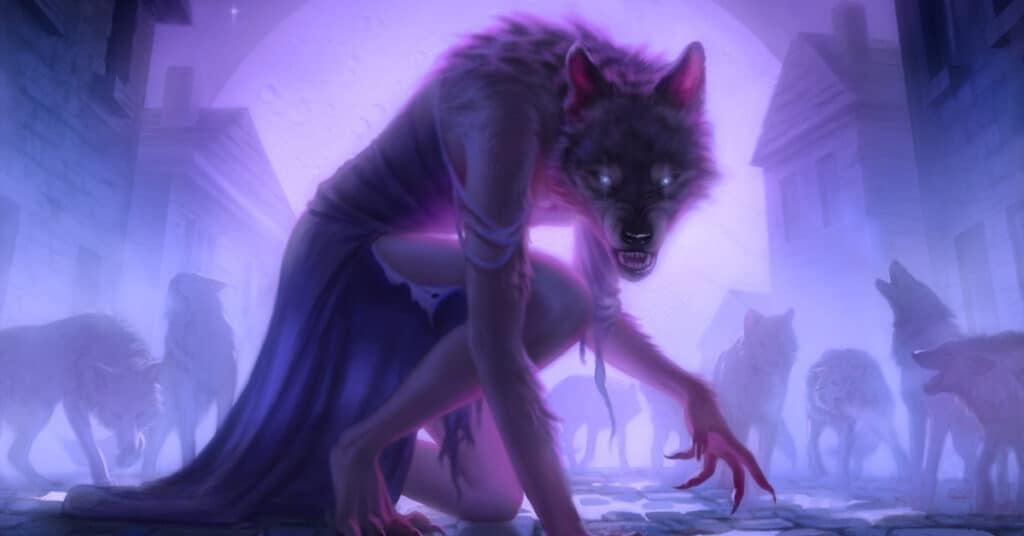
- Creature Type: Humanoid
- Size: Medium
- Speed: xxx feet
- Bestial Instincts: Proficiency in ane: Acrobatics, Athletics, Intimidation, Survival.
- Darkvision: lx feet
- Shifting: Assume a unmerciful appearance as a bonus action that lasts for i minute or until y'all die (proficiency bonus number of times per long rest). Proceeds 2 x Proficiency bonus temporary hitting points and an additional bonus based on your lycanthropic ancestry. These include the Beasthide (more than temporary hp, +1 AC), Longtooth (unarmed strike deals 1d6 + Strength), Swiftstride (+10 feet walking speed, movement every bit a reaction without provoking opportunity attacks), and Wildhunt (reward on Wisdom checks and no fauna tin can attack you with advantage while shifted).
Descendants of lycanthropes (like werewolves, wererats, weretigers, etc.), shifters can't fully alter shape but instead partially take on the traits of their more bestial ancestor.
A mixture of great nature skills and a lycanthropic version of the barbaric's rage ability make for a really fantastic player race — although I wish that Beasthide and Wildhunt weren't so much better than the other two options.
Shifters could make incredible Rangers or perhaps Druids that don't shapeshift using wild shape.
28. Tabaxi
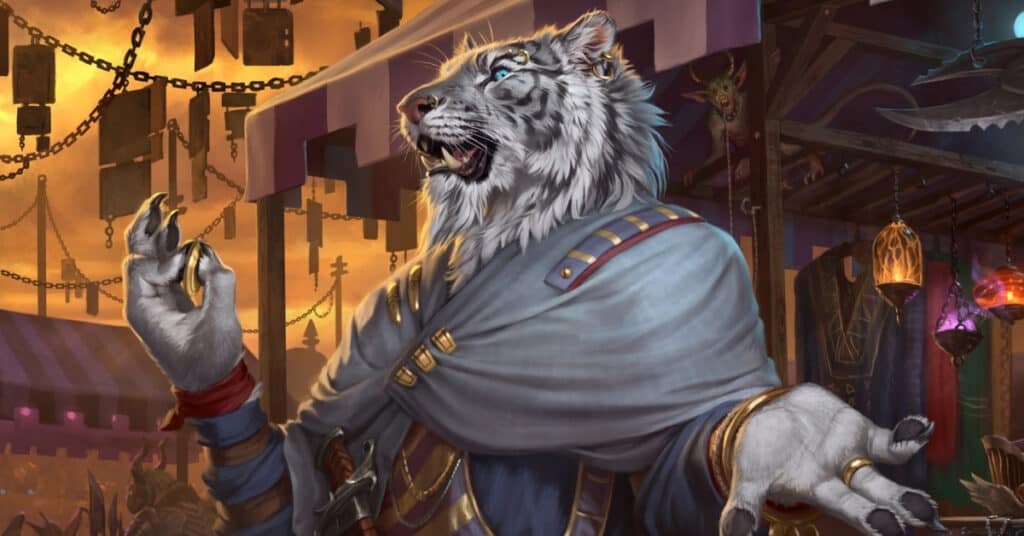
- Animate being Type: Humanoid
- Size: Medium
- Speed: 30 feet (walking and climbing)
- True cat'south Claws: Unarmed strikes deal 1d6 + Strength slashing damage.
- True cat'due south Talent: Proficiency in Perception and Stealth.
- Darkvision: threescore anxiety
- Feline Agility: Double your move speed for one round. Can't use once again until y'all move 0 feet on one turn.
Anthropomorphic cat people — endowed with all the grace, agility, and speed that entails — the Tabaxi are children of a divine beingness from the upper planes known every bit the Cat Lord.
Widespread and various, some Tabaxi display more catlike tendencies than others.
A Tabaxi's speed and agility (not to mention unsurpassed climbing speed) make them fine candidates for Rogues, Rangers, and Monks.
29. Tortle

- Creature Type: Humanoid
- Size: Medium or modest
- Speed: xxx feet
- Claws: Unarmed strikes deal 1d6 + Force slashing damage.
- Concord Jiff: ane hour
- Natural Armor: Your shell grants a base AC of 17, although you lot tin't wearable armor, and your Dexterity doesn't affect your AC. You can yet employ a shield.
- Nature's Intuition: Proficiency with ane: Fauna Handling, Medicine, Nature, Perception, Stealth, or Survival.
- Shell Defense: Retreat into your beat out as an action for a +iv Ac bonus and advantage on Force and Constitution saves. Your speed drops to 0, you lot are prone, you have Disadvantage on Dexterity saving throws, you tin't have reactions, and the but activity you can take is a bonus action to emerge from your shell.
Nomadic turtle folk who carry their homes on their backs and live up and down the coasts of the material airplane.
With a base AC of 17, tortles might exist the best contender for an otherwise squishy wizard or sorcerer class in the game — although this reduction of dependency on Dexterity and Constitution tin assistance whatever multi-ability-dependent course (like a bard) as well.
30. Triton
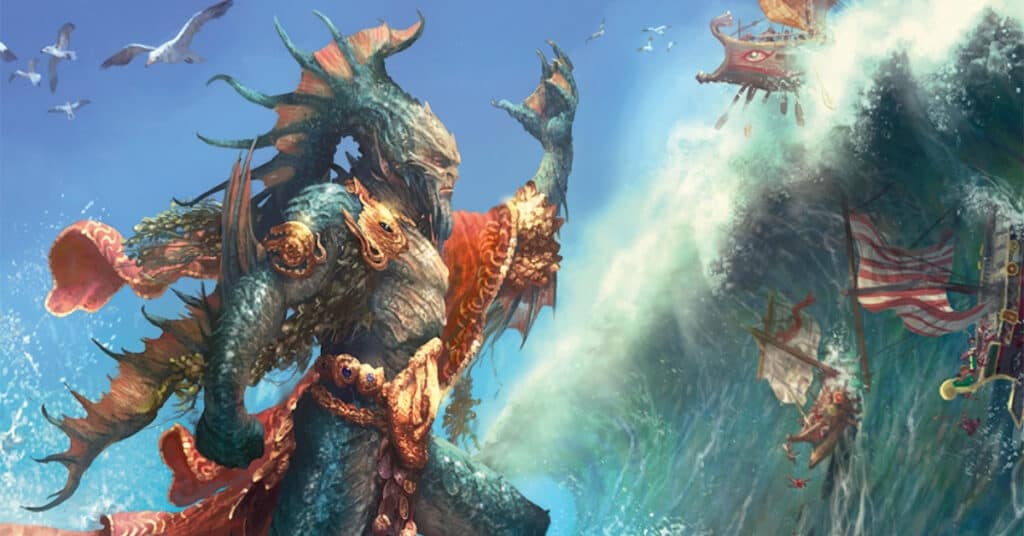
- Fauna Type: Humanoid
- Size: Medium
- Speed: thirty feet (walking and swimming)
- Amphibious: Breathe air and h2o
- Control Air and Water: Cast Fog Cloud, Gust of Wind (at tertiary level), or Water Walk (at fifth) with this power one time per long rest or using a spell slot.
- Darkvision: sixty feet
- Emissary of the Bounding main: Communicate simple ideas with beasts, elementals, and monstrosities with a swimming speed.
- Guardian of the Depths: Resistance to cold damage.
Natives of the elemental airplane of water, tritons are protectors of the cloth aeroplane's oceans from the threat of elemental evil.
They build peachy cities on the ocean floor and patrol the depths using their webbed hands and feet to swim as fast as most creatures walk.
Ideally suited to aquatic and coastal campaigns, Tritons accept a dandy assortment of traits from darkvision to a common damage-type resistance and some useful innate spellcasting (assuming you're near water).
31. Yuan-Ti
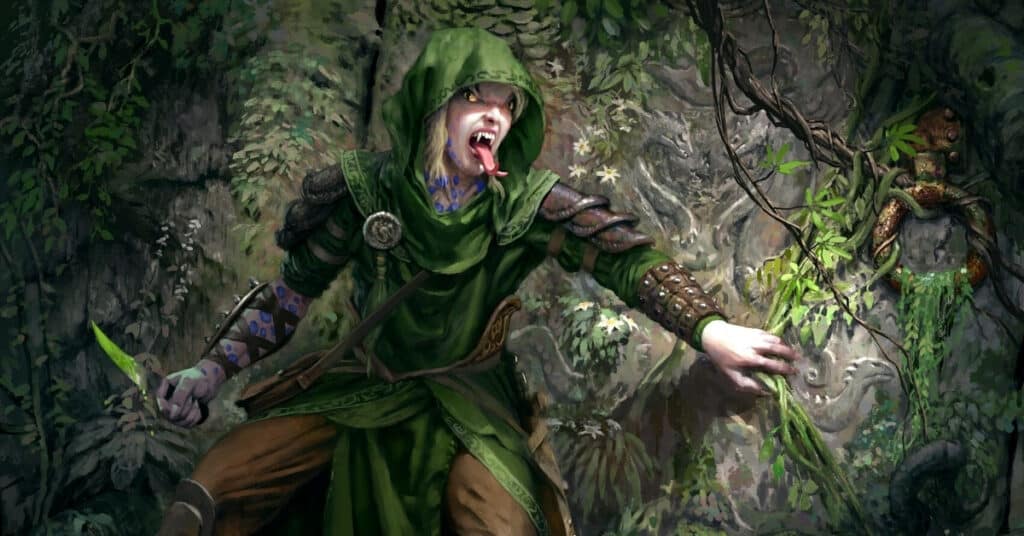
- Beast Blazon: Humanoid
- Size: Medium or modest
- Speed: thirty feet
- Darkvision: 60 feet
- Magic Resistance. Reward on saving throws against spells.
- Toxicant Resilience: Reward on saving throws against poison and resistance to poison harm.
- Serpentine Spellcasting: You know the poison spray cantrip and can bandage brute friendship an unlimited number of times but only on snakes. You can as well cast suggestion (at 3rd level) in one case per long rest or using a 2nd-level spell slot.
The descendants of humans who turned themselves into snake people as function of foul, aboriginal rituals, the Yuan-Ti used to be an almost entirely monstrous people just have grown as a civilization over the centuries and these days make for a really narratively interesting race to play.
Yuan-Ti blend toxicant resistance with innate spellcasting and an (unsurprising) analogousness for snakes which, depending on the campaign you're in, could encounter you collect a seriously sizable serpent army.
Their magic resistance is a universally powerful trait and helps the Yuan-Ti fit into just about whatever class or party role.
5e Races That Give Intelligence,
Source: https://blackcitadelrpg.com/playable-character-races-5e/
Posted by: browncoble1958.blogspot.com


0 Response to "5e Races That Give Intelligence"
Post a Comment